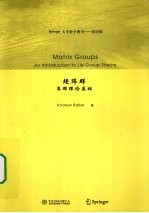

矩阵群 李群理论基础 英文PDF电子书下载
- 电子书积分:12 积分如何计算积分?
- 作 者:AndrewBaker编著
- 出 版 社:北京:清华大学出版社
- 出版年份:2009
- ISBN:9787302214847
- 页数:330 页
Part Ⅰ.Basic Ideas and Examples 3
1.Real and Complex Matrix Groups 3
1.1 Groups of Matrices 3
1.2 Groups of Matrices as Metric Spaces 5
1.3 Compactness 12
1.4 Matrix Groups 15
1.5 Some Important Examples 18
1.6 Complex Matrices as Real Matrices 29
1.7 Continuous Homomorphisms of Matrix Groups 31
1.8 Matrix Groups for Normed Vector Spaces 33
1.9 Continuous Group Actions 37
2.Exponentials, Differential Equations and One-parameter Sub-groups 45
2.1 The Matrix Exponential and Logarithm 45
2.2 Calculating Exponentials and Jordan Form 51
2.3 Differential Equations in Matrices 55
2.4 One-parameter Subgroups in Matrix Groups 56
2.5 One-parameter Subgroups and Differential Equations 59
3.Tangent Spaces and Lie Algebras 67
3.1 Lie Algebras 67
3.2 Curves,Tangent Spaces and Lie Algebras 71
3.3 The Lie Algebras of Some Matrix Groups 76
3.4 Some Observations on the Exponential Function of a Matrix Group 84
3.5 SO(3) and SU(2) 86
3.6 The Complexification of a Real Lie Algebra 92
4.Algebras,Quaternions and Quaternionic Symplectic Groups 99
4.1 Algebras 99
4.2 Real and Complex Normed Algebras 111
4.3 Linear Algebra over a Division Algebra 113
4.4 The Quaternions 116
4.5 Quaternionic Matrix Groups 120
4.6 Automorphism Groups of Algebras 122
5.Clifford Algebras and Spinor Groups 129
5.1 Real Clifford Algebras 130
5.2 Clifford Groups 139
5.3 Pinor and Spinor Groups 143
5.4 The Centres of Spinor Groups 151
5.5 Finite Subgroups of Spinor Groups 152
6.Lorentz Groups 157
6.1 Lorentz Groups 157
6.2 A Principal Axis Theorem for Lorentz Groups 165
6.3 SL2(C) and the Lorentz Group Lor(3,1) 171
Part Ⅱ.Matrix Groups as Lie Groups 181
7.Lie Groups 181
7.1 Smooth Manifolds 181
7.2 Tangent Spaces and Derivatives 183
7.3 Lie Groups 187
7.4 Some Examples of Lie Groups 189
7.5 Some Useful Formulae in Matrix Groups 193
7.6 Matrix Groups are Lie Groups 199
7.7 Not All Lie Groups are Matrix Groups 203
8.Homogeneous Spaces 211
8.1 Homogeneous Spaces as Manifolds 211
8.2 Homogeneous Spaces as Orbits 215
8.3 Projective Spaces 217
8.4 Grassmannians 222
8.5 The Gram-Schmidt Process 224
8.6 Reduced Echelon Form 226
8.7 Real Inner Products 227
8.8 Symplectic Forms 229
9.Connectivity of Matrix Groups 235
9.1 Connectivity of Manifolds 235
9.2 Examples of Path Connected Matrix Groups 238
9.3 The Path Components of a Lie Group 241
9.4 Another Connectivity Result 244
Part Ⅲ.Compact Connected Lie Groups and their Classification 244
10.Maximal Tori in Compact Connected Lie Groups 251
10.1 Tori 251
10.2 Maximal Tori in Compact Lie Groups 255
10.3 The Normaliser and Weyl Group of a Maximal Torus 259
10.4 The Centre of a Compact Connected Lie Group 263
11.Semi-simple Factorisation 267
11.1 An Invariant Inner Product 267
11.2 The Centre and its Lie Algebra 270
11.3 Lie Ideals and the Adjoint Action 272
11.4 Semi-simple Decompositions 276
11.5 Structure of the Adjoint Representation 278
12.Roots Systems,Weyl Groups and Dynkin Diagrams 289
12.1 Inner Products and Duality 289
12.2 Roots systems and their Weyl groups 291
12.3 Some Examples of Root Systems 293
12.4 The Dynkin Diagram of a Root System 297
12.5 Irreducible Dynkin Diagrams 298
12.6 From Root Systems to Lie Algebras 299
Hints and Solutions to Selected Exercises 303
Bibliography 323
Index 325
- 《市政工程基础》杨岚编著 2009
- 《SQL与关系数据库理论》(美)戴特(C.J.Date) 2019
- 《零基础学会素描》王金著 2019
- 《计算机网络与通信基础》谢雨飞,田启川编著 2019
- 《生物质甘油共气化制氢基础研究》赵丽霞 2019
- 《联吡啶基钌光敏染料的结构与性能的理论研究》李明霞 2019
- 《情报学 服务国家安全与发展的现代情报理论》赵冰峰著 2018
- 《英汉翻译理论的多维阐释及应用剖析》常瑞娟著 2019
- 《花时间 我的第一堂花艺课 插花基础技法篇》(日)花时间编辑部编;陈洁责编;冯莹莹译 2020
- 《Photoshop CC 2018基础教程》温培利,付华编著 2019
- 《市政工程基础》杨岚编著 2009
- 《家畜百宝 猪、牛、羊、鸡的综合利用》山西省商业厅组织技术处编著 1959
- 《《道德经》200句》崇贤书院编著 2018
- 《高级英语阅读与听说教程》刘秀梅编著 2019
- 《计算机网络与通信基础》谢雨飞,田启川编著 2019
- 《看图自学吉他弹唱教程》陈飞编著 2019
- 《法语词汇认知联想记忆法》刘莲编著 2020
- 《培智学校义务教育实验教科书教师教学用书 生活适应 二年级 上》人民教育出版社,课程教材研究所,特殊教育课程教材研究中心编著 2019
- 《国家社科基金项目申报规范 技巧与案例 第3版 2020》文传浩,夏宇编著 2019
- 《流体力学》张扬军,彭杰,诸葛伟林编著 2019
- 《大学计算机实验指导及习题解答》曹成志,宋长龙 2019
- 《指向核心素养 北京十一学校名师教学设计 英语 七年级 上 配人教版》周志英总主编 2019
- 《大学生心理健康与人生发展》王琳责任编辑;(中国)肖宇 2019
- 《大学英语四级考试全真试题 标准模拟 四级》汪开虎主编 2012
- 《大学英语教学的跨文化交际视角研究与创新发展》许丽云,刘枫,尚利明著 2020
- 《北京生态环境保护》《北京环境保护丛书》编委会编著 2018
- 《复旦大学新闻学院教授学术丛书 新闻实务随想录》刘海贵 2019
- 《大学英语综合教程 1》王佃春,骆敏主编 2015
- 《大学物理简明教程 下 第2版》施卫主编 2020
- 《指向核心素养 北京十一学校名师教学设计 英语 九年级 上 配人教版》周志英总主编 2019
